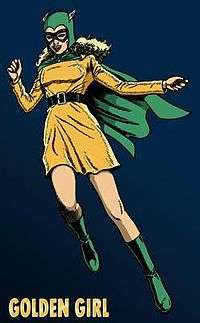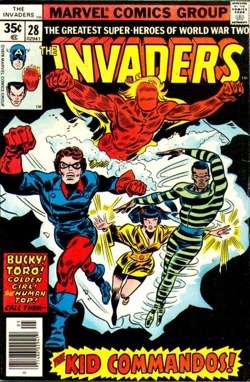Golden Girl
Golden Girl is the name of two fictional superheroine characters appearing in American comic books published by Marvel Comics, the first of them during the 1930-1940s period known to historians and collectors as the Golden Age of Comic Books.
Betsy Ross
| Golden Girl | |
|---|---|
 | |
| Publication information | |
| Publisher | Marvel Comics |
| First appearance | Captain America Comics #1 |
| Created by |
Joe Simon (writer) Jack Kirby (artist) |
| In-story information | |
| Alter ego | Betsy Ross |
| Team affiliations |
Women's Auxiliary Army Corps All-Winners Squad |
| Abilities | Wears bulletproof cape |
Publication history
Marvel Comics' first Golden Girl, Elizabeth Ross, first appeared, without yet a superhero identity, as Betty Ross in Captain America Comics #1 (cover-dated March 1941). A supporting character who appeared in occasional stories, she assisted the U.S. Army and was a love interest for Steve Rogers, Captain America's real identity. She succeeded Bucky as Captain America's sidekick in issue #66 (Dec. 1947), in the 12-page story "Golden Girl", by an unconfirmed writer and by penciller Syd Shores. Later, it was retconned that this was not Steve Rogers but Jeff Mace, the superhero Patriot and the third man to be called Captain America.[1] Golden Girl appeared in Captain America stories through issue #74 (Oct. 1949), except for issue #71, and also in the Captain America stories in Marvel Mystery Comics #87-88 and #92 (Aug. & Oct. 1948, June 1949). Betsy's non superhero design has changed over the years; when she first appeared she was blonde, but later stories had her with red hair and wearing a blonde wig as part of her Golden Girl costume.
She was not specified as having been related to a Colonel Ross, a U.S. Army officer, in the Captain America story "The Wound No Man Could See" in Marvel Mystery Comics #88 (Oct. 1948).[2] The 2010 miniseries Captain America: Patriot retroactively revealed that she was the aunt of General Thunderbolt Ross, and the great-aunt of his daughter Betty Ross, two characters introduced in The Incredible Hulk #1 (May 1962).
Fictional character biography
Immediately before and during most of World War II, Betsy Ross was a member of the U.S. Army's Women's Auxiliary Army Corps, and had previously worked as a waitress and later an FBI agent. She became a friend and eventual girlfriend of Army Private Steve Rogers, unaware of his dual identity as Captain America, whom she admired and who had saved her on more than one occasion. She was kind and resourceful, but not especially strong at first. Betsy investigated fortune tellers Sando and Omar and exposed them as spies. In issue #6 (Sept. 1941), she was captured by the Imperial Japanese spy known as Fang along with Bucky, but was rescued by Captain America. After the attack on Pearl Harbor and the United States' official entry into the war, she soon became involved in more missions that had her opposing Nazi and Imperial Japanese forces. Over the course of the comics, Ross grows into a tough and capable ally of Captain America and Bucky.
She had adapted her name slightly to Betsy Ross — the name of the U.S. colonial-era woman to whom legend ascribes sewing the first American flag — by the time that Captain America's sidekick, the second Bucky (Fred Davis) was shot and wounded. The third Captain America, Jeffrey Mace, who'd succeeded the M.I.A. Rogers and the killed-in-action William Naslund, revealed his civilian identity to Ross and gave her a bulletproof cape previously owned by Naslund and trained her as his new partner, the costumed crime-fighter Golden Girl.
For Ross' first mission as Golden Girl, she and Captain America investigated strange seismic activity in a city, leading them to encounter Mr. Zrr from Dimension Zee and assisted him in capturing Denton Smith and Cecil Babylon, two criminals who found safe haven in that dimension. After many more adventures, culminating in a battle with the Red Skull in Hell,[3] Ross and Mace married by 1953 and eventually retired from their superhero duties.[4]
After Mace died of cancer, Betsy moved to Valhalla Villas, a Florida retirement community for ex-heroes and ex-villains. She was one of the Golden Age heroes who went back into action one last time after being temporarily de-aged as part of the "Last Days" part of the Secret Wars storyline.[5]
Powers and abilities
Betsy Ross had no superpowers but was a skilled hand-to-hand combatant and wore a bulletproof cape that belonged to William Naslund, formerly the Spirit of '76.
Gwenny Lou Sabuki
| Golden Girl | |
|---|---|
|
Golden Girl (middle) appears alongside the Kid Commandos. From The Invaders #28. | |
| Publication information | |
| Publisher | Marvel Comics |
| First appearance | The Invaders #26 (March 1978) |
| Created by |
Roy Thomas Frank Robbins |
| In-story information | |
| Alter ego | Gwendolyne "Gwenny" Lou Sabuki |
| Team affiliations |
Kid Commandos V-Battalion Penance Council |
| Notable aliases | Golden Woman |
| Abilities |
Energy and light generation Golden force beam projection via her hands |
Publication history
Gwendolyne "Gwenny" Lou Sabuki was the second Golden Girl introduced by Marvel, making her first appearance in 1978, but her World War II-era character predates the post-war, Betsy Ross, Golden Girl (see above). Created by writer Roy Thomas and penciller Frank Robbins in the retcon series The Invaders #26 (March 1978), she had appeared, sans power, as Gwenny Lou, gaining her powers in the following issue, #27 (April 1978). She went on to appear as Golden Girl in #28 (May 1978) and #38 (March 1979).
Fictional character biography
During World War II, teenaged Gwenny Lou Sabuki, the daughter of Japanese-American scientist Dr. Sam Sabuki, was present at a stateside battle in which sidekicks Bucky (real name James Buchanan Barnes) and Toro (Thomas Raymond) of the superhero team the Invaders fought the supervillain Agent Axis. There one of Dr. Sabuki's inventions accidentally gave Gwenny Lou and her friend David "Davey" Mitchell superhuman powers. Gwenny Lou gained the power to generate light and energy and project golden force beams from her hands, while Mitchell gained the ability to spin at superhuman speeds. She became Golden Girl and he the Human Top.[6] The four youthful heroes defeated Agent Axis and later formed the Kid Commandos, who were allied with the adult Invaders.
Gwenny Lou later helped found the post-war organization known as the V-Battalion. Gwenny eventually changed her superhero name to Golden Woman, before she died in 1961. Her son and her granddaughter became the superheroes Golden Sun and Goldfire, respectively, though Golden Sun died when his own daughter was five years old.[7] Another of Gwenny Lou's granddaughters eventually became the Japanese heroine Radiance.[8]
Powers and abilities
After being exposed to a scientific invention, the Golden Girl gained the power to generate light and energy. She can also project golden force beams from her hands.
Other media
Betsy Ross appeared in the Captain America portion of the Marvel Super Heroes TV Show (1966).
References
- ↑ Captain America: Patriot #1 (Nov. 2010) at the Grand Comics Database.
- ↑ The Grand Comics Database at its ''Marvel Mystery Comics #88 entry, queries, "Col. Ross (Golden Girl's father?)"
- ↑ Captain America Comics #74 (Oct. 1949)
- ↑ The Official Handbook of the Marvel Universe vol. 2, #5 (April 1986).
- ↑ Ant-Man: Last Days #1
- ↑ The Invaders #27 (April 1978)
- ↑ Citizen V and the V-Battalion #2 (July 2001)
- ↑ Guerrero, Tony 'G-Man' (28 March 2014). "Exclusive: James Robinson Talks ALL-NEW INVADERS, Original Sin, and New Characters". ComicVine.com. Retrieved 29 December 2014.
External links
- Grand Comics Database
- All-New Official Handbook of the Marvel Universe A to Z: Update 2 - Adam II to Zodiac (May 2007)
- International Catalogue of Superheroes: Golden Girl
